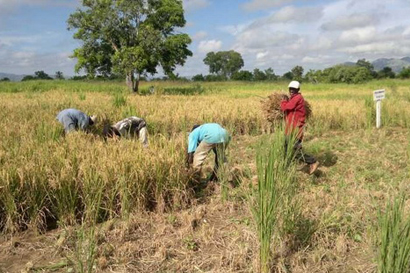
Providing Fish, Teaching People How to Fish: On the Road to Reconstruction in Haiti
The inauguration of the Taiwan-built New Hope Village in Haiti took place on August 18 following the completion of all construction work at the site. The invitation to local residents to formally move in to the village, which is located in Savane Diane, came after 28 months in which the International Cooperation and Development Fund (TaiwanICDF) provided a range of vocational training programs, together with guidance on agricultural production. During this period, TaiwanICDF personnel assisted local people to engage in reconstruction work, transforming an area of wilderness into a bustling residential site, and will continue to provide similar guidance in the future.
By next year, when residents have become sufficiently proficient in agricultural production, the TaiwanICDF will withdraw from the village and move on to developing projects in other parts of Haiti. The organization hopes to facilitate development throughout the country and will continue to draw on Taiwan’s own experiences as part of efforts to assist local people in its partner countries.
Haiti was struck by a 7.0-magnitude earthquake on January 12, 2010 — a grave disaster which killed as many as 200,000 people, injured countless more and left millions homeless. In the immediate aftermath of the disaster, quality of life and environmental conditions in and around Haiti’s capital, Port-au-Prince, deteriorated markedly after large numbers of survivors were forced to seek shelter on the city’s streets, in turn leading the Haitian government to promote resettlement in the suburbs and further afield.
When the Taiwanese government offered to assist with Haiti’s reconstruction efforts, proposing an initiative involving the construction of a new village, Haitian authorities touted Savane Diane, a site in Haiti’s central highlands, as an ideal location for the TaiwanICDF to establish New Hope Village and engage residents in its Haiti Earthquake Calamity Recovery Assistance Project.
As part of project implementation to date, beneficiary households are now in their third year of agricultural production, and output is gradually beginning to stabilize.
Previously, a lack of well-paved roads and basic infrastructure in the area caused problems. During heavy rains, flooding from local rivers disrupted supplies and transportation, while reclamation work rendered roads rutted and waterlogged, severely hampering the movement of farm machinery and making it virtually impossible to exploit the best production opportunities at appropriate times.
TaiwanICDF personnel involved in project implementation took steps to overcome these difficulties, yielding positive impacts for project counterparts and beneficiary households, and putting operations back on track. The 322.5 hectares of land set aside for reclamation is now fully planted and under cultivation, and maize, sorghum, pigeon peas and other crops continue to develop well, providing residents with a reliable source of food, as well as a surplus that can be sold on.
With people flocking to the area, the TaiwanICDF has also established a rice mill, a simple marketplace and other facilities, so that local residents can sell their goods at a twice-weekly market. Furthermore, the organization has provided training in bamboo crafts to increase sources of additional revenue for householders in the village, assisting participants to produce simple bamboo furniture and bamboo-woven goods. All trainees graduating from the course have been presented with a set of tools, to encourage the sustained production of bamboo products in the future. In addition to being used by village residents, bamboo furniture and woven goods have also been sold at market.
Post-disaster reconstruction is a long-term endeavor. Since many aspects of the Haiti Earthquake Calamity Recovery Assistance Project represent a departure from the conventional aid model employed by Taiwan Technical Missions, the TaiwanICDF has been keen to cooperate closely with Haiti’s Ministry of Agriculture. Both sides assigned project managers to jointly manage the project, and hired local technicians to implement project work, working closely with local government authorities and respecting local autonomy and demands on the ground, which has yielded outstanding results.
Knowledge has been the most powerful driving force behind the arduous challenge of resettling 215 households, which has seen numerous tangible and intangible difficulties arising along the way. Although the TaiwanICDF will provide local residents with the core knowledge that they need, the plan isn’t to build “another Taiwan,” but rather to encourage local people to take advantage of the knowledge they acquire in such a way that Haitian people can survive on their own. Through these efforts, the TaiwanICDF continues to pursue its vision of becoming the best partner for sustainable development.
- Update: 2018/03/01
- Hits:321

